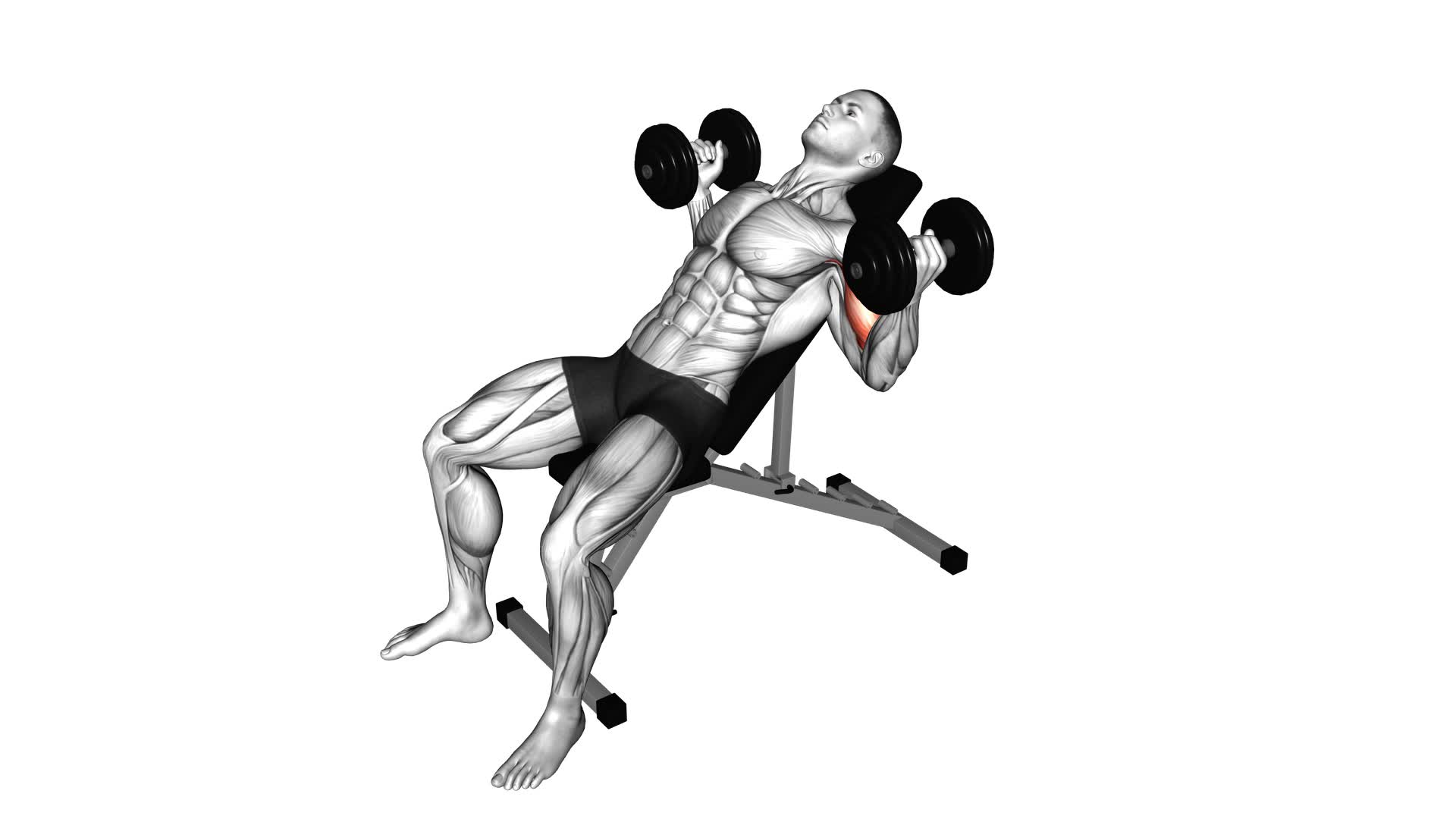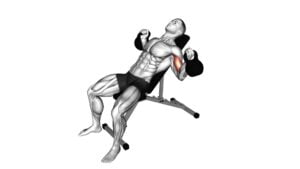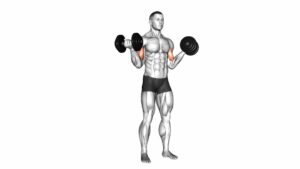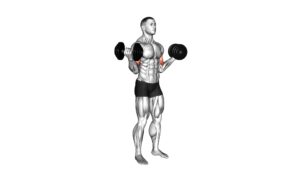Dumbbell Incline Inner Biceps Curl – Video Exercise Guide & Tips

Are you looking to strengthen and tone your biceps? If so, the dumbbell incline inner biceps curl is the perfect exercise for you.
Watch This Exercise Video
In this video exercise guide, we will show you how to properly set up the incline bench and perform the exercise with correct form and technique.
We will also provide tips to maximize the effectiveness of the exercise and recommend the right dumbbell weight for beginners.
Say goodbye to flabby arms and hello to sculpted biceps!
Key Takeaways
- Targets the inner part of the biceps for increased muscle definition and strength
- Isolates the biceps and ensures maximum engagement of targeted muscle fibers
- Creates a more balanced and symmetrical appearance
- Improves overall arm strength and stability
Benefits of the Dumbbell Incline Inner Biceps Curl
The dumbbell incline inner biceps curl offers a multitude of benefits for your upper arms. This exercise specifically targets the inner part of your biceps, helping to increase muscle definition and strength in that area. By performing this exercise on an incline bench, you're able to isolate the biceps and ensure maximum engagement of the targeted muscle fibers.
One of the main benefits of the dumbbell incline inner biceps curl is its effectiveness in maximizing results. By focusing on the inner part of your biceps, you're able to sculpt and shape that area, creating a more balanced and symmetrical appearance. Additionally, this exercise helps to improve overall arm strength and stability, which can enhance your performance in other upper body exercises.
While the dumbbell incline inner biceps curl is a great exercise for targeting the inner biceps, it's important to note that there are alternative exercises that can also provide similar benefits. Some alternatives include the cable inner biceps curl and the hammer curl. These exercises target the inner biceps from different angles, providing variation to your workout routine and helping to prevent plateaus.
How to Set up the Incline Bench for This Exercise
To properly set up the incline bench for this exercise, ensure stability and adjustability. Here's how you can position the incline bench for maximum effectiveness:
- Place the incline bench in a position that allows you to sit comfortably with your back supported.
- Adjust the incline bench angle to around 45 degrees. This angle will target your inner biceps and provide the necessary resistance for the exercise.
- Make sure the bench is stable and secure before starting the exercise. Check for any wobbling or instability that could disrupt your form and increase the risk of injury.
By setting up the incline bench correctly, you create the ideal position for the inner biceps curl. This will help you achieve better results and prevent any unnecessary strain on your muscles or joints.
Now that you have the incline bench in the proper position, let's move on to the next section where we'll discuss the proper form and technique for the inner biceps curl.
Proper Form and Technique for the Inner Biceps Curl
Now that you have the incline bench properly positioned, how do you execute the inner biceps curl with proper form and technique?
To maximize bicep gains and get the most out of this exercise, it's important to focus on maintaining correct form throughout the movement. Start by sitting on the incline bench with your back firmly pressed against the pad and your feet flat on the floor. Hold a dumbbell in each hand, palms facing each other, and let your arms hang straight down. This is your starting position.
As you begin the curl, keep your upper arms stationary and exhale as you curl the dumbbells upwards, rotating your wrists so that your palms face your shoulders at the top of the movement. Hold for a brief pause to fully contract your biceps.
Then, inhale as you slowly lower the dumbbells back to the starting position, keeping your wrists rotated throughout the entire movement.
Remember to avoid swinging your body or using momentum to lift the weights. Focus on isolating your biceps and using them to perform the movement.
You can also try different variations of bicep curls, such as alternating curls or hammer curls, to target different areas of the biceps.
Recommended Dumbbell Weight for Beginners
To get started with the recommended dumbbell weight for beginners, consider carrying on from the previous discussion by gradually increasing the resistance you use, ensuring proper form and technique. When it comes to dumbbell weight selection, it's crucial to find the right balance between challenging yourself and maintaining control throughout the exercise. Here are some tips to help you progress as a beginner:
- Start with a lighter weight that allows you to perform the exercise with proper form and technique.
- As you become more comfortable and confident, gradually increase the weight to continue challenging your muscles.
- Pay attention to how your body feels during the exercise. If you feel any pain or discomfort, decrease the weight or seek guidance from a fitness professional.
By following these guidelines, you can ensure a safe and effective progression for beginners. Remember, the goal is to gradually increase the resistance over time, allowing your muscles to adapt and grow stronger.
Now that you have a better understanding of the recommended dumbbell weight for beginners, let's move on to the next section, where we'll discuss some tips to maximize the effectiveness of the exercise.
Tips to Maximize the Effectiveness of the Exercise
To maximize the effectiveness of the dumbbell incline inner biceps curl, focus on maintaining proper form throughout the exercise.
Keep your back flat against the bench and your elbows tucked in close to your body.
This will ensure that you're targeting the inner biceps and minimizing the involvement of other muscle groups.
Proper Form Techniques
To maximize the effectiveness of the dumbbell incline inner biceps curl, consistently maintain proper form throughout the exercise. Here are some tips to help you achieve the best results:
- Focus on your breathing: Proper breathing techniques can enhance your performance and increase the effectiveness of the exercise. Inhale deeply before starting the curl and exhale as you lift the dumbbells.
- Explore variations: Adding variations to your routine can keep your workouts interesting and challenge your muscles in different ways. Try using different grip positions or alternating arms to target the inner biceps from various angles.
- Engage your core: Keeping your core muscles engaged throughout the exercise won't only provide stability but also improve your overall posture and balance.
By following these tips, you can ensure that you're performing the dumbbell incline inner biceps curl correctly and maximizing its benefits.
Now let's move on to the next section, where we'll discuss how to specifically target the inner biceps.
Targeting Inner Biceps
To effectively target your inner biceps and maximize the effectiveness of the dumbbell incline inner biceps curl, focus on incorporating specific exercises and techniques into your routine. In addition to the incline inner biceps curl, you can try other inner biceps exercises such as the hammer curl or the concentration curl. These variations of biceps curls specifically target the inner part of your biceps, helping to build strength and definition in that area.
When performing the incline inner biceps curl, make sure to maintain proper form and control throughout the movement. Keep your elbows close to your body, squeeze your biceps at the top of the movement, and slowly lower the weight back down. By incorporating these exercises and techniques into your routine, you can effectively target your inner biceps and maximize your results.
Now, let's move on to discussing common mistakes to avoid during the inner biceps curl.
Common Mistakes to Avoid During the Inner Biceps Curl
Avoiding common mistakes is crucial for maximizing the effectiveness of the Inner Biceps Curl exercise. To ensure you get the most out of your workout and prevent any potential injuries, here are some common mistakes to avoid:
- Using too much weight: It may be tempting to go heavy, but using weights that are too heavy can compromise your form and increase the risk of injury. Start with lighter weights and gradually increase as your strength improves.
- Swinging the weights: Momentum is the enemy of an effective biceps curl. Swinging the weights not only reduces the effectiveness of the exercise but also puts unnecessary strain on your muscles and joints. Keep your movements controlled and focus on squeezing your biceps throughout the entire range of motion.
- Neglecting proper form: It's important to maintain proper form during the Inner Biceps Curl. Avoid rounding your back, hunching your shoulders, or using your momentum to lift the weights. Instead, keep your back straight, shoulders back and down, and engage your core for stability.
Frequently Asked Questions
How Many Sets and Reps Should I Do for the Dumbbell Incline Inner Biceps Curl?
To determine the sets and reps for the dumbbell incline inner biceps curl, consider your fitness level.
For beginners, start with 2-3 sets of 8-12 reps.
As you progress, increase the intensity by adding more weight or doing more sets and reps.
Advanced individuals can aim for 3-4 sets of 10-15 reps.
Remember to listen to your body and adjust accordingly.
Can I Do the Dumbbell Incline Inner Biceps Curl Without an Incline Bench?
Yes, you can do the dumbbell incline inner biceps curl without an incline bench. However, using an incline bench has its benefits.
It allows for a greater range of motion and targets the inner biceps more effectively.
If you don't have an incline bench, you can try alternative exercises like standing inner biceps curls or preacher curls.
These exercises will still work your inner biceps, but may not provide the same level of intensity as the incline variation.
Is It Normal to Feel a Burning Sensation in the Biceps During This Exercise?
Feeling a burning sensation in your biceps during the dumbbell incline inner biceps curl is normal. It's a sign that your muscles are working hard.
To ensure proper form, make sure your back is flat against the bench and your elbows are tucked in close to your sides. Avoid swinging the weights or using momentum to lift them.
Focus on controlled movements and squeeze your biceps at the top of the curl.
Can I Use Resistance Bands Instead of Dumbbells for the Inner Biceps Curl?
Yes, you can definitely use resistance bands instead of dumbbells for the inner biceps curl. Resistance bands provide an alternative to the incline bench, allowing you to work your biceps from different angles.
They offer adjustable resistance and are portable, making them convenient for home or travel workouts. Just make sure to choose a resistance band that provides enough tension to challenge your biceps muscles.
Are There Any Modifications or Variations of the Dumbbell Incline Inner Biceps Curl for People With Shoulder or Wrist Injuries?
If you have shoulder or wrist injuries, there are modifications and variations for the dumbbell incline inner biceps curl.
You can try shoulder-friendly modifications like using a lower weight or performing the exercise on a flat bench instead of an incline.
For wrist-friendly variations, you can use resistance bands instead of dumbbells or try using an EZ bar for a more comfortable grip.
Remember to consult with a professional before making any changes to your workout routine.
Conclusion
In conclusion, the dumbbell incline inner biceps curl is an effective exercise for targeting and strengthening the biceps muscles. By using proper form and technique, and gradually increasing the dumbbell weight, beginners can benefit from this exercise.
To maximize its effectiveness, it's important to avoid common mistakes and follow the recommended tips. Incorporating this exercise into a well-rounded workout routine can help individuals achieve their fitness goals.

Author
Years ago, the spark of my life’s passion ignited in my mind the moment I stepped into the local gym for the first time. The inaugural bead of perspiration, the initial endeavor, the very first surge of endorphins, and a sense of pride that washed over me post-workout marked the beginning of my deep-seated interest in strength sports, fitness, and sports nutrition. This very curiosity blossomed rapidly into a profound fascination, propelling me to earn a Master’s degree in Physical Education from the Academy of Physical Education in Krakow, followed by a Sports Manager diploma from the Jagiellonian University. My journey of growth led me to gain more specialized qualifications, such as being a certified personal trainer with a focus on sports dietetics, a lifeguard, and an instructor for wellness and corrective gymnastics. Theoretical knowledge paired seamlessly with practical experience, reinforcing my belief that the transformation of individuals under my guidance was also a reflection of my personal growth. This belief holds true even today. Each day, I strive to push the boundaries and explore new realms. These realms gently elevate me to greater heights. The unique combination of passion for my field and the continuous quest for growth fuels my drive to break new ground.







